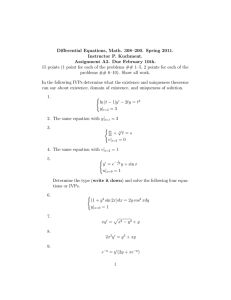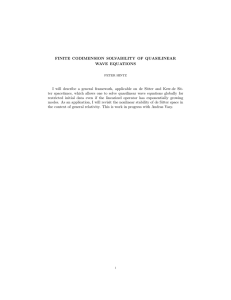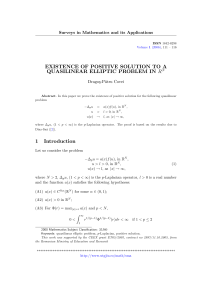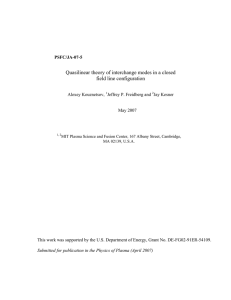Electronic Journal of Differential Equations, Vol. 2006(2006), No. 84, pp.... ISSN: 1072-6691. URL: or
advertisement
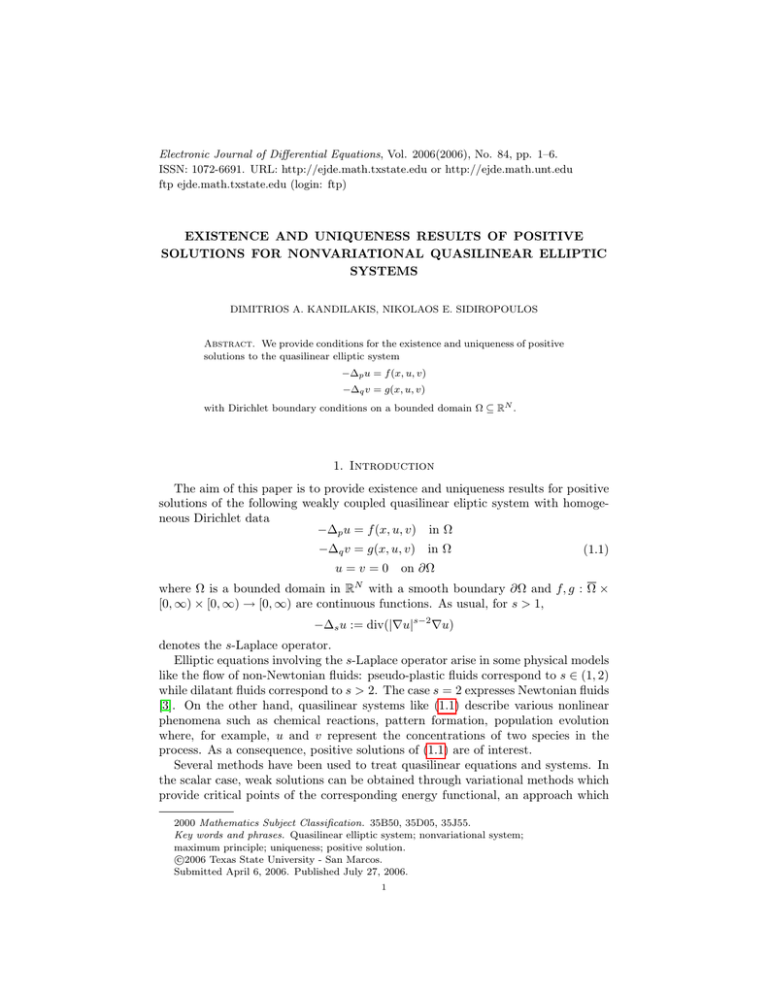
Electronic Journal of Differential Equations, Vol. 2006(2006), No. 84, pp. 1–6.
ISSN: 1072-6691. URL: http://ejde.math.txstate.edu or http://ejde.math.unt.edu
ftp ejde.math.txstate.edu (login: ftp)
EXISTENCE AND UNIQUENESS RESULTS OF POSITIVE
SOLUTIONS FOR NONVARIATIONAL QUASILINEAR ELLIPTIC
SYSTEMS
DIMITRIOS A. KANDILAKIS, NIKOLAOS E. SIDIROPOULOS
Abstract. We provide conditions for the existence and uniqueness of positive
solutions to the quasilinear elliptic system
−∆p u = f (x, u, v)
−∆q v = g(x, u, v)
with Dirichlet boundary conditions on a bounded domain Ω ⊆ RN .
1. Introduction
The aim of this paper is to provide existence and uniqueness results for positive
solutions of the following weakly coupled quasilinear eliptic system with homogeneous Dirichlet data
−∆p u = f (x, u, v) in Ω
−∆q v = g(x, u, v)
in Ω
(1.1)
u = v = 0 on ∂Ω
where Ω is a bounded domain in RN with a smooth boundary ∂Ω and f, g : Ω ×
[0, ∞) × [0, ∞) → [0, ∞) are continuous functions. As usual, for s > 1,
−∆s u := div(|∇u|s−2 ∇u)
denotes the s-Laplace operator.
Elliptic equations involving the s-Laplace operator arise in some physical models
like the flow of non-Newtonian fluids: pseudo-plastic fluids correspond to s ∈ (1, 2)
while dilatant fluids correspond to s > 2. The case s = 2 expresses Newtonian fluids
[3]. On the other hand, quasilinear systems like (1.1) describe various nonlinear
phenomena such as chemical reactions, pattern formation, population evolution
where, for example, u and v represent the concentrations of two species in the
process. As a consequence, positive solutions of (1.1) are of interest.
Several methods have been used to treat quasilinear equations and systems. In
the scalar case, weak solutions can be obtained through variational methods which
provide critical points of the corresponding energy functional, an approach which
2000 Mathematics Subject Classification. 35B50, 35D05, 35J55.
Key words and phrases. Quasilinear elliptic system; nonvariational system;
maximum principle; uniqueness; positive solution.
c
2006
Texas State University - San Marcos.
Submitted April 6, 2006. Published July 27, 2006.
1
2
D. A. KANDILAKIS, N. E. SIDIROPOULOS
EJDE-2006/84
is also fruitful in the case of potential systems i.e, the nonlinearities on the right
hand side are the gradient of a C 1 −functional [2], [7], [10] . However, due to the
loss of the variational structure, the treatment of nonvariational systems like (1.1)
is more complicated and is based mostly on topological methods [1].
Recently, there have been significant studies of (1.1). Dalmasso [6] provided
existence and uniqueness results for positive solutions in the semilinear case p =
q = 2 with the assumption that f is a function of v and g is a function of u, that is,
(1.1) is the Lane-Emden system. Existence results in the case f and g are monomials
of u and v are also provided in [5], while the quasilinear Lane-Emden system was
studied by Hai [9]. In this paper we adopt the method in [9] to complement and
extend corresponding results in the aforementioned papers.
2. Main Results
We make the following assumptions:
(H1) f, g : Ω × [0, ∞) × [0, ∞) → [0, ∞) are continuous functions such that
(i) u → f (x, u, v) and u → g(x, u, v) are nondecreasing for every x ∈ Ω and
v ≥ 0.
(ii) v → f (x, u, v) and v → g(x, u, v) are nondecreasing for every x ∈ Ω and
u ≥ 0.
(H2) For each a > 0,
1
lim sup
z→0+
1
h p−1 (z, ak q−1 (z, z))
= ∞,
z
where h(u, v) := minx∈Ω f (x, u, v) and k(u, v) := minx∈Ω g(x, u, v).
(H3) For each b > 0,
1
1
lim inf
z→+∞
F p−1 (z, bG q−1 (z, z))
= 0,
z
where F (u, v) := maxx∈Ω f (x, u, v) and G(u, v) := maxx∈Ω g(x, u, v).
(H4)
1
1
lim inf
z→+∞
G q−1 (z, z)
= 0 and
z
lim sup
z→0+
k q−1 (z, z)
= ∞.
z
Suppose now that D is a sub-domain of Ω with D ⊂ Ω. Let δ(.) := χD (.), the
characteristic function of D. The solutions ϕ,
e ψe of the problems
−∆p ϕ
e=δ
ϕ
e=0
in Ω
on ∂Ω
and
−∆q ψe = δ
ψe = 0
in Ω
on ∂Ω
will be useful in what follows. Let ϕ (respectively ψ) denote the torsion functions
relative to Ω and to the operators −∆p (respectively −∆q ), that is,
−∆p ϕ = 1
in Ω
ϕ = 0 on ∂Ω
(2.1)
EJDE-2006/84
EXISTENCE AND UNIQUENESS RESULTS
3
and
−∆q ψ = 1
in Ω
(2.2)
ψ = 0 on ∂Ω.
Note that, by the strong comparison principle [8], there exist positive numbers M
e ϕ, ψ ≥ m on D.
and m such that ϕ
e ≥ M ϕ, ψe ≥ M ψ in Ω and ϕ,
e ψ,
Our existence and uniqueness results are the following.
Theorem 2.1. Let f, g satisfy (H1)-(H4). Then (1.1) has a positive solution (u, v).
Theorem 2.2. Let f, g satisfy (H1) and assume that there exist positive constants
r1 , r2 , s1 , s2 such that
f (x, s, t) g(x, s, t)
,
sr1
ss1
are nonincreasing for x ∈ Ω and t ≥ 0, and
f (x, s, t)
,
tr 2
g(x, s, t)
t s2
are nonincreasing for x ∈ Ω and s ≥ 0. If one of the following conditions is
satisfied:
(i)
(ii)
(iii)
(iv)
(v)
r1 +r2
p−1
s1 +s2
q−1
s1 +s2
q−1
r1 +r2
p−1
r1 +r2
p−1
(r1 +r2 )s1 +s2 (p−1)
< 1,
(p−1)(q−1)
(s1 +s2 )r2 +r1 (q−1)
and
< 1,
(p−1)(q−1)
r1 +r2
and p−1 < 1,
1 +(s1 +s2 )(p−1)r2
1 +s2
, sq−1
< 1 and (r1 +r2 )(q−1)r
(p−1)(q−1)2
1 +(s1 +s2 )(p−1)s2
1 +s2
, sq−1
> 1 and (r1 +r2 )(q−1)s
(p−1)2 (q−1)
< 1 and
<1
<1
>1
<1
< 1,
< 1,
then (1.1) admits at most one positive solution.
Remark 2.3. (i) If f (u, v) = uα + v β and g(u, v) = uγ + v δ , α, β, γ, δ ≥ 0, then
(H2)-H(4) require
α < p − 1,
max{γ, δ} < q − 1,
and
max{γ, δ}β < (p − 1)(q − 1).
(ii) Let f (u, v) = uα v β and g(u, v) = uγ v δ . Then (H2)-H(4) are satisfied if
α+
γ+δ
β <p−1
q−1
and γ + δ < q − 1.
Proof of Theorem 2.1. In view of (H2) and (H4), there exists ε ∈ (0, 1) such that
1
1
M h p−1 (εm, mg q−1 (εm, εm)) ≥ ε
and
1
M k q−1 (εm, εm) ≥ ε.
(2.3)
For (w1 , w2 ) ∈ C(Ω) × C(Ω), let T (w1 , w2 ) := (u, v) be the solution of
−∆p u = f (x, max(w1, εϕ), v)
in Ω
−∆q v = g(x, max(w1, εϕ), max(w2, εψ))
u = v = 0 on Ω
in Ω
(2.4)
By standard arguments we can show that T : C(Ω) × C(Ω) → C(Ω) × C(Ω) is completely continuous. By (H3) and (H4) there exists a number R > max{|ϕ|∞ , |ψ|∞ }
4
D. A. KANDILAKIS, N. E. SIDIROPOULOS
EJDE-2006/84
such that
1
1
F p−1 (R, |ψ|∞ G q−1 (R, R))|ϕ|∞ ≤ R,
1
G q−1 (R, R)|ψ|∞ ≤ R.
We claim that T (B(0, R) × B(0, R)) ⊆ B(0, R) × B(0, R), where B(0, R) denotes
the closed ball centered at 0 with radius R in C(Ω). Indeed, let w1 , w2 ∈ C(Ω),
with |w1 |∞ ≤ R and |w2 |∞ ≤ R. Then, in view of (2.2),
−∆q v = g(x, max(w1, εϕ), max(w2, εψ))
1
≤ G(R, R)(−∆q ψ) = −∆q (G q−1 (R, R)ψ)
in Ω,
which implies by strong comparison principle [8] that
1
v ≤ G q−1 (R, R)ψ.
Consequently, |v|∞ ≤ R. On the other hand,
−∆p u = f (x, max(w1, εϕ), v) ≤ F (R, v)
1
1
≤ F (R, G q−1 (R, R)ψ) ≤ F (R, G q−1 (R, R)|ψ|∞ ),
which, by the strong comparison principle, implies
1
1
u ≤ F p−1 (R, g q−1 (R, R)|ψ|∞ )|ϕ|∞ ≤ R,
and so |u|∞ ≤ R, proving the claim.
By the Schauder fixed point theorem, T has a fixed point (u, v) with |u|∞ ≤ R
and |v|∞ ≤ R. We will show next that |u|∞ ≥ εϕ and |v|∞ ≥ εψ. Since
−∆q v = g(x, max(u, εϕ), max(v, εψ)) ≥ g(x, εϕ, εψ)
(
g(x, εm, εm) in D
≥
0
in Ω\D
(
k(εm, εm) in D
≥
0
in Ω\D,
it follows from the strong comparison principle and (2.3) that
1
1
v ≥ k q−1 (εm, εm)ψe ≥ M k q−1 (εm, εm)ψ ≥ εψ.
Consequently,
−∆p u = f (x, max(u, εϕ), v)
1
e
≥ f (x, max(u, εϕ), k q−1 (εm, εm)ψ)
(
1
f (x, max(u, εϕ), k q−1 (εm, εm)m) in D
≥
0
in Ω\D
(
1
h(εm, mk q−1 (εm, εm)m) in D
≥
0
in Ω\D,
and so
1
1
˜
1
1
u ≥ h p−1 (εm, k q−1 (εm, εm)m)ϕ ≥ M h p−1 (εm, mk q−1 (εm, εm)) ≥ εϕ.
The proof is complete.
EJDE-2006/84
EXISTENCE AND UNIQUENESS RESULTS
5
Proof of Theorem 2.2. We will provide the proof only for the cases (i), (iii) and
(iv). Let (u, v) and (u1 , v1 ) be positive solutions of (1). As in [4], we define
∆ = δ1 ∈ (0, 1] : u ≥ εu1 and v ≥ εv1 in Ω for ε ∈ [0, δ1 ] .
Clearly ∆ 6= ∅. Let δ = sup ∆. We will show that δ = 1. So assume that δ < 1.
Let (i) hold. Then
−∆p u ≥ f (x, δu1 , v) ≥ δ r1 f (x, u1 , v) ≥ δ r1 δ r2 f (x, u1 , v1 ) = δ r1 +r2 f (x, u1 , v1 ),
and since
−∆p (δ
r1 +r2
p−1
u1 ) = δ r1 +r2 f (x, u1 , v1 ),
it follows that
u≥δ
r1 +r2
p−1
u1 .
(2.5)
Using (2.5) in the equation for v in (1.1), we get
−∆q v ≥ g(x, δ
r1 +r2
p−1
u1 , v) ≥ g(x, δ
r1 +r2
p−1
u1 , δv1 ) ≥ δ
(r1 +r2 )s1
p−1
g(x, u1 , δv1 ).
Therefore,
−∆q v ≥ δ
(r1 +r2 )s1
p−1
δ s2 g(x, u1 , v1 ) ≥ δ
(r1 +r2 )s1 +s2 (p−1)
(p−1)
g(x, u1 , v1 ),
and so
v≥δ
(r1 +r2 )s1 +s2 (p−1)
(p−1)(q−1)
v1 ,
(2.6)
contradicting the definition of δ.
In the case (iii) we have
−∆q v ≥ g(x, δu1 , v) ≥ δ s1 g(x, u1 , v) ≥ δ s1 δ s2 g(x, u1 , v1 ) = δ s1 +s2 g(x, u1 , v1 ).
Since
−∆q (δ
s1 +s2
q−1
v1 ) = δ s1 +s2 g(x, u1 , v1 ),
it follows that
v≥δ
s1 +s2
q−1
v1 .
(2.7)
In view of inequalities (2.5) and (2.7) we have a contradiction with the definition
of δ.
Assume now that (iv) holds. Working as in (2.5) we get
v≥δ
s1 +s2
q−1
v1 .
(2.8)
Using (2.5) and (2.8) in the equation for u yields
−∆p u ≥ f (x, δ
≥δ
r1 +r2
p−1
u1 , δ
s1 +s2
q−1
v1 )
(r1 +r2 )(q−1)r1 +(s1 +s2 )(p−1)r2
(q−1)(p−1)
= −δ
f (x, u1 , v1 )
(r1 +r2 )(q−1)r1 +(s1 +s2 )(p−1)r2
(q−1)(p−1)
∆p u1 .
Thus,
u≥δ
(r1 +r2 )(q−1)r1 +(s1 +s2 )(p−1)r2
(p−1)2 (q−1)
u1 .
6
D. A. KANDILAKIS, N. E. SIDIROPOULOS
EJDE-2006/84
On the other hand,
−∆q v ≥ g(x, δ
≥δ
r1 +r2
p−1
u1 , δ
s1 +s2
q−1
v1 )
(r1 +r2 )(q−1)r1 +(s1 +s2 )(p−1)r2
(q−1)(p−1)
= −δ
g(x, u1 , v1 )
(r1 +r2 )(q−1)r1 +(s1 +s2 )(p−1)r2
(q−1)(p−1)
∆q v1 .
Consequently,
(r1 +r2 )(q−1)r1 +(s1 +s2 )(p−1)r2
(p−1)(q−1)2
v≥δ
v1 ,
contradicting the definition of δ.
Thus δ = 1, i.e., v ≥ v1 and u ≥ u1 . Similarly, v ≤ v1 and u ≤ u1 . Consequently,
u = u1 and v = v1 .
References
[1] C.O. Alves, D.G. deFigueiredo, Nonvariational elliptic systems, Discr. Contin. Dyn. Systems
8 (2) (2002), 289-302.
[2] A. Ambrosetti, J. G. Azorero, I. Peral; Existence and multiplicity results for some nonlinear
elliptic equations: a survey, Rendiconti di Matematica, SerieVII, 20 (2000), 167-198.
[3] C. Atkinson, K. El-Ali, Some boundary value problems for the Bingham model, J. NonNewtonian fluid Mech. 41 (1992), 339-363.
[4] H. Brezis, S. Kamin, Sublinear elliptic equations in RN , Manuscripta Math. 74 (1992), 87-106.
[5] P. Clement, J. Fleckinger, E. Mitidieri, F. de Thelin, Existence of positive solutions for a
nonvariational quasilinear elliptic system, J. Differential Equations 166 (2000), 455-477.
[6] R. Dalmasso, Existence and uniqueness of positive solutions of semilinear elliptic systems,
Nonlinear Analysis TMA 39 (2000), 559-568.
[7] D. G. de Figueiredo, Semilinear elliptic systems, in Nonlinear Functional Analysis and Applications to Differential Equations, World Scientific (1997), 125-152 (A. Ambrosetti, K.-C.
Chang, I. Ekeland, eds).
[8] M. Guedda, L. Veron, Quasilinear elliptic equations involving critical Sobolev exponents,
Nonlinear Analysis TMA 13 (1989), 879-902.
[9] D.D. Hai, Existence and uniqueness of solutions for quasilinear elliptic systems, Proc. AMS
133 no 1 (2004), 223-228.
[10] N. M. Stavrakakis and N. Zographopoulos, Multiplicity and regularity results for some quasilinear elliptic systems on RN , Nonlinear Analysis TMA 50 (2002), 55-69.
Dimitrios A. Kandilakis
Department of Sciences, Technical University of Crete, 73100 Chania, Greece
E-mail address: dkan@science.tuc.gr
Nikolaos E. Sidiropoulos
Department of Sciences, Technical University of Crete, 73100 Chania, Greece
E-mail address: nsid@science.tuc.gr

